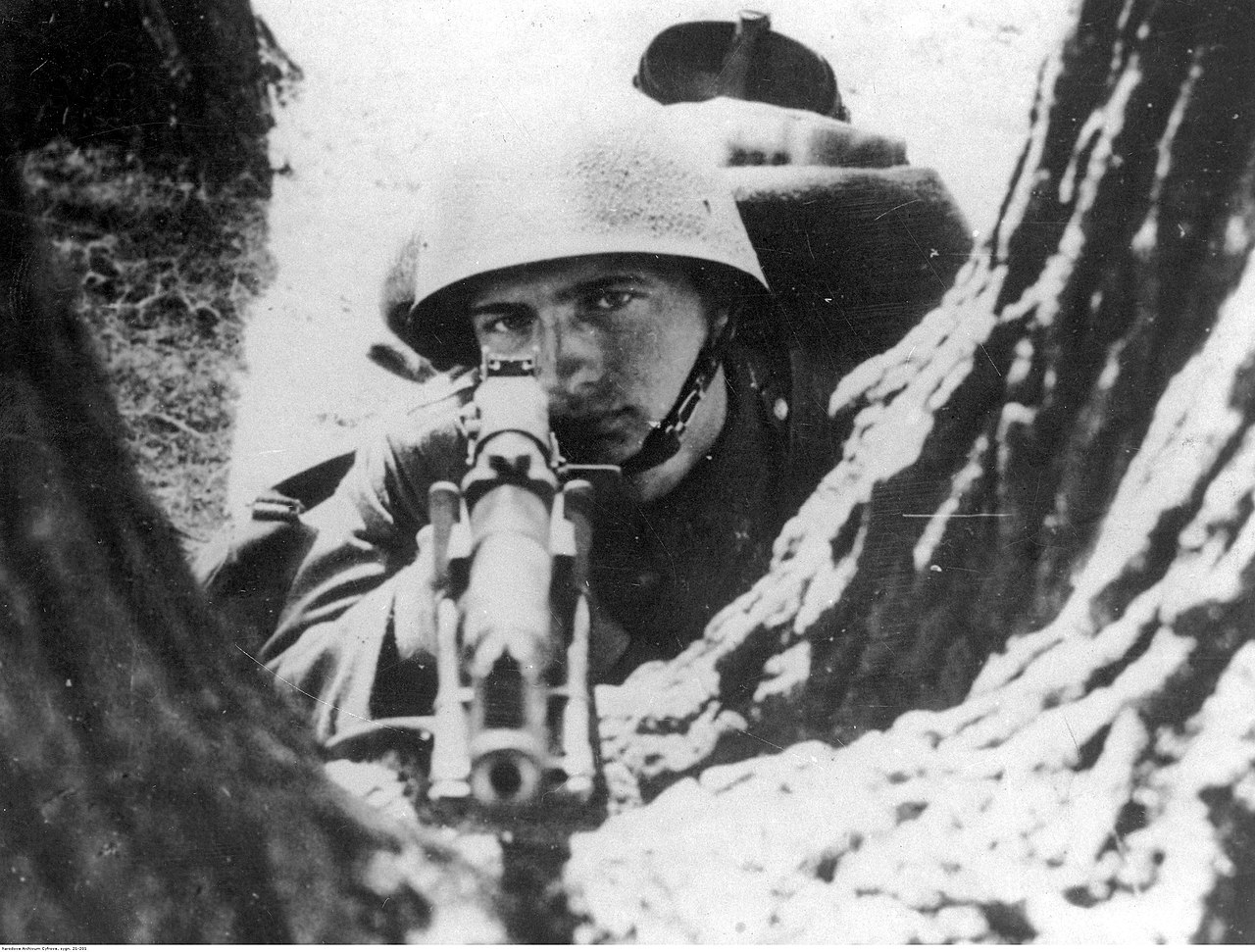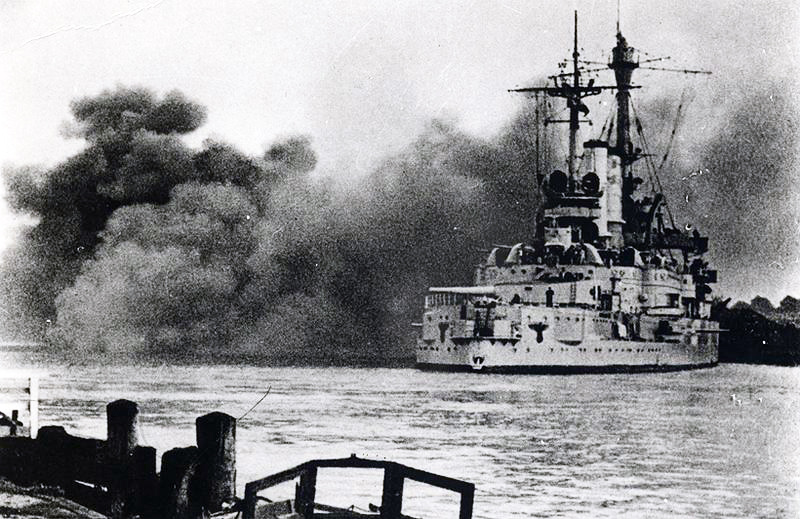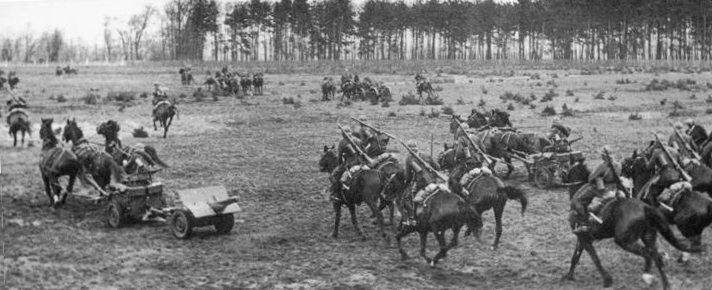| The Deluge:
Polish
Campaign, 1939
By Mike Bennighof, PhD
July 2020
 While Adolf Hitler made threats against Poland in his early writings, as Chancellor of Germany his policies did not at first alarm the Poles. Poland and Germany signed a 10-year non-aggression pact in January 1934, and for the next several years relations remained cool but correct. Poland stood by while Germany absorbed first Austria and then Czechoslovakia, and took the opportunity during the 1938 Czech crisis to seize the disputed territory of Teschen from the Czechs. While Adolf Hitler made threats against Poland in his early writings, as Chancellor of Germany his policies did not at first alarm the Poles. Poland and Germany signed a 10-year non-aggression pact in January 1934, and for the next several years relations remained cool but correct. Poland stood by while Germany absorbed first Austria and then Czechoslovakia, and took the opportunity during the 1938 Czech crisis to seize the disputed territory of Teschen from the Czechs.
But Hitler had embarked on a program of economic expansion that would inevitably cause the German economy to “overheat” - the growth of the 1930’s, spurred by government spending, had resulted in so much consumer spending that producers had over-expanded their capacity and inflation loomed. Hitler and the Nazis feared the return of inflation, the terror of which had allowed them into power, and did not want to curb their seeming success with soaring interest rates. This illusory economic success was the basis for Hitler remaining in office, and he would not surrender it, whatever the cost. Instead he sought the other cure for an overheated economy: turning that excess capacity to war.
When Czechoslovakia backed down without fighting, Hitler lost his opportunity for a war. The Czechs finished evacuating the Sudetenland on 10 October 1938. Two weeks later, German Foreign Minister Joachim Ribbentrop demanded the return of the free city of Danzig to Germany, offering a 25-year non-aggression pact and a guarantee of Poland's borders in exchange.

A Polish BAR man awaits the hereditary enemy.
In March 1939, the Germans bullied the Czech president into accepting German “protection” and Czechoslovakia ceased to exist. German troops entered Prague on the 15th, and on the 23rd Lithuania yielded up the port of Memel to the Germans. On the 31st the British Prime Minister, Neville Chamberlain, announced that Britain and France would act together to support Poland in case of a German attack.
On 3 April, the German high command issued a secret directive, known as Case White, for the invasion of Poland, setting 1 September as the target date for the attack. Mobilization would take place only weeks before the attack, to maintain secrecy. Not fooled, the Poles began a secret mobilization of their own, but anxious to maintain the support of their allies, this remained very low-key until late August.
Case White
The German plan deployed overwhelming force against Poland from three directions. To the north of Poland lay East Prussia, a German province separated from the rest of Germany by the so-called “Polish Corridor.” The Third Army had five regular infantry divisions and a cavalry brigade, plus two divisions and three brigades of second-line troops and a makeshift panzer division. These would guard the border on the eastern part of the province and strike directly south toward Warsaw, drawing Polish forces away from other tasks.
From the south, the new Axis satellite of Slovakia would provide the staging areas for the Austrian divisions of the 14th Army - the only time the Wehrmacht’s Austrian component would operate together during World War II. These forces included one panzer division, one light division, three infantry divisions and three mountain divisions, plus three small Slovak infantry divisions. Their task would be to capture of the great cities of Galicia: Krakow and Lwow.
The main weight of the German attack would come from Army Group South, mustered in the province of Silesia. Eighth Army, Tenth Army and the left wing of Fourteenth Army together mustered 18 infantry divisions, three light divisions, three panzer divisions and three motorized divisions. These would rush forward toward the Vistula River, then turn to strike Warsaw from the south and trap the Polish armies between them and Army Group North.

The elderly battleship Schleswig-Holstein fired the first shots of World War II. At such close range, most of them failed to explode.
Army Group North would strike from Pomerania with seven infantry divisions, two panzer divisions and two motorized divisions. Their task would be to break through to East Prussia, and turn southward to form the other arm of the pincer movement trapping the Polish armies in Poznan. Almost 200 kilometers of frontier between the two army groups, including the approaches to Berlin itself, were screened only by border guard forces.
Plan Z
Many problems faced Polish defense planners. The strategic situation placed Poland between German-controlled territories on three sides. The relative balance of forces gave Germany overwhelming advantages in numbers of troops alone, not to mention the more modern weapons of war like tanks, planes and artillery pieces that Poland’s weaker economy could not match. And worst of all, Poland’s allies offered no material assistance and in fact hampered Polish preparations: desperate for hard currency, the Poles sold 260 of their desperately-needed modern anti-tank guns to Britain, while the British hedged on a reciprocal deal for even-more-desperately-needed Hurricane fighter planes and never delivered them.
The French promised to begin an offensive across the Rhine within two weeks of a German attack on Poland. Citing this commitment as a reason not to provoke the Germans, the French also pressured the Poles to delay mobilization - issuing their last warning two days before the Germans attacked.
Yielding the regions on the German border would mean giving up most of Poland’s industrial capacity as well as areas inhabited almost exclusively by ethnic Poles. Without early mobilization, the bulk of the army’s reliable reservists would be overrun while still at their homes and jobs. The Polish Army would only be able to call up units from eastern Poland, filled with many Ukrainians, Byelorussians and Lithuanians - men considered politically suspect and lesser fighters than the “real” Poles. The Polish command chose to try to defend the border regions.

Armored train Smialy the Bold.
Poland could muster 30 regular infantry divisions and 11 cavalry brigades. Full mobilization would have yielded another 25 divisions and three more cavalry brigades. With full cooperation from the French, Poland might be able to survive the attack. Without that assistance, and without full mobilization, the Poles could not hope to hold off the full weight of the German war machine for more than a few weeks.
Poland's initial deployment has been criticized by historians and others since 1939, but in the absence of strong French responses on Germany's western border it’s hard to see how a different strategy would have done more than delay the inevitable slightly longer. The slight possibility of halting the Germans on the frontier and allowing the army to fully mobilize was probably as good a strategy as any.
The Attack
When the attack came, it took full advantage of the weak Polish deployment. The Poles fought with fanatical determination, but the Germans not only had overall advantages in numbers, they had weighted their attack to give themselves overwhelming superiority on narrow fronts. The Poles reeled back from the Silesian and Pomeranian fronts thanks to superior German infantry-artillery attacks, not to the slashing attacks of the panzers highlighted by Nazi propaganda.
Those new weapons of war made their impact felt in the days after the initial assault. The Poles desperately tried to fall back and form new lines, but again and again the German mechanized forces either got their first, or rolled them out before they could consolidate their positions. Undeniable Polish bravery often only resulted in greater casualty lists.

Polish cavalry strike back, 14 September 1939.
The Poles rallied around Warsaw, fending off German attacks for close to three weeks. Warsaw had been the scene of the miraculous defeat of the Red Army in 1920, and so it was to the capital that the commanders of shattered Polish units directed their men. As a place where an impossible victory had been won a generation earlier, it gave great comfort to Poles and most Polish soldiers thought they could still win. But German terrorist tactics broke the will of their leaders, who could not bear to see their civilians slaughtered by the barbarian invaders. The French, it was now obvious, had no intention of lifting a finger to aid their allies. Warsaw surrendered with a large, intact and well-supplied garrison.
As if the German attack and French non-response were not enough, Poland faced yet a third betrayal - a completely unexpected attack by the Soviet Union. On 24 August the Germans and Soviets had signed a non-aggression treaty of their own, assigning huge swaths of Eastern Europe to Soviet occupation in exchange for large shipments of raw materials and a free hand for the Germans in their new war. The Poles had conducted their own negotiations with the Soviets, along with the British and French, up until 17 August when they had reached an impasse due to Polish refusals to allow the Red Army onto Polish territory. That the Soviets would turn around and make a deal with the Germans does not seem to have occurred to Polish leaders.
Therefore, when the Red Army rolled into eastern Poland on 17 September, it caught Poland’s government and military command completely by surprise. At many places, Polish peasants welcomed the Soviets, thinking they were coming to fight the Germans on Poland’s behalf. Thoroughly demoralized, the Polish leadership gave up all hope of holding a “redoubt” in the southwest and ordered their troops to escape across the borders of Hungary, Romania and Lithuania. Poles would continue to fight from foreign soil, just as they had done in prior centuries.
Don’t wait to put The Deluge on your game table! Join the Gold Club and find out how to get it before anyone else, at a better price than anyone else!
Sign up for our newsletter right here. Your info will never be sold or transferred; we'll just use it to update you on new games and new offers.
Mike Bennighof is president of Avalanche Press and holds a doctorate in history from Emory University. A Fulbright Scholar and NASA Journalist in Space finalist, he has published over 100 books, games and articles on historical subjects.
He lives in Birmingham, Alabama with his wife, three children and his dog, Leopold. Leopold approves of this message.
|
